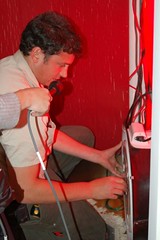 I was talking with Matt Golden of Sustainable Spaces, a home performance contractor in San Francisco, at the annual Affordable Comfort conference in Cleveland last month. Matt is what I like to call a "friend of Home Energy," someone who is enthusiastic about our common cause: making homes healthier and more energy efficient. And Matt is a great communicator and advocate for the home performance profession. He wrote a great article, "Finding a Partnership Between Solar and Energy Efficiency" for the Home Energy Special Issue, Solar and Efficiency--Meeting the Energy Needs of the 21st Century, published this past April.
I was talking with Matt Golden of Sustainable Spaces, a home performance contractor in San Francisco, at the annual Affordable Comfort conference in Cleveland last month. Matt is what I like to call a "friend of Home Energy," someone who is enthusiastic about our common cause: making homes healthier and more energy efficient. And Matt is a great communicator and advocate for the home performance profession. He wrote a great article, "Finding a Partnership Between Solar and Energy Efficiency" for the Home Energy Special Issue, Solar and Efficiency--Meeting the Energy Needs of the 21st Century, published this past April.
While I talked with Matt in a conference room in Cleveland, he pulled two clippings out of his backpack: one was from USA Today and the other was from the San Francisco Chronicle. There is a photo of a blower door in each article! Matt was recently interviewed for a QUEST Radio spot, “Sniffing Out Indoor Air Pollution” (aired on May 11th). And there he is in a QUEST flickr photo, with a blower door! Pretty soon the blower door will be as familiar to Americans as dual-flush toilets, blown-in cellulose insulation, and low-e windows. Matt and I were very excited about this development.
Abba Anderson wrote an article, "The History of the Blower Door" for the November/December 1995 issue of Home Energy. "Perhaps no piece of equipment has changed the way energy professionals look at buildings more than the blower door," writes Anderson. "Over the past 15 years, entire diagnostic procedures have evolved around this relatively simple device that can make subtle, but measurable, changes in house pressures."
Building scientists at Princeton University first used blower doors for research in 1977. Blower doors fit tight in doorways and have fans that can pressurize or depressurize a whole house-- in other words, make a house blow or suck. By monitoring the pressures inside and outside of the house and the flow rate of the fan, home performance contractors can get a good idea how leaky a house is. Leaky houses (thousands of cubic feet per minute, or CFM, of air leakage, for example) can be fixed, and tight houses (less than one hundred CFM, for example) can be retrofit with mechanical ventilation so that a controlled amount of healthy fresh air is brought into the house.
When builders began to build tighter homes, in the 1970s and 1980s, stagnant indoor air began to cause moisture problems. Now the mantra among the best homebuilders is "Build it tight and ventilate right." Do you know where your indoor air is coming from?
